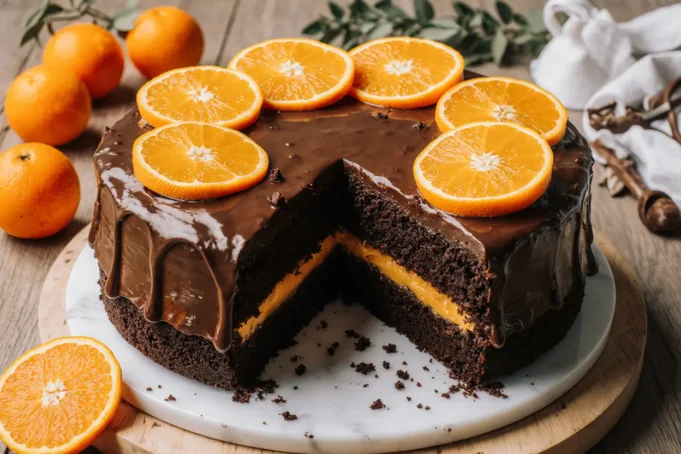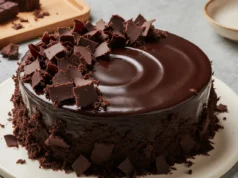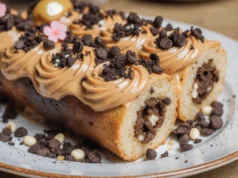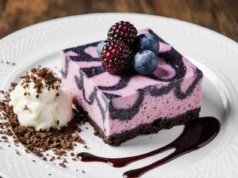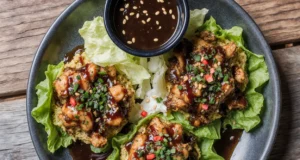Did you know that 73% of home bakers struggle to achieve the perfect balance between chocolate richness and citrus brightness in their desserts? This chocolate orange cake recipe description will revolutionize your baking game by delivering that elusive harmony in every bite. The secret lies in understanding how citrus oils interact with cocoa compounds – a culinary science that transforms ordinary ingredients into an extraordinary dessert experience. This comprehensive recipe description combines traditional European baking techniques with modern flavor enhancement methods, ensuring your chocolate orange cake becomes the centerpiece of any celebration.
Ingredients List
Transform your kitchen into a gourmet bakery with these carefully selected ingredients:
For the Chocolate Cake Base:
- 2 cups all-purpose flour (substitute: almond flour for gluten-free option)
- 3/4 cup unsweetened cocoa powder (Dutch-processed preferred for deeper flavor)
- 2 cups granulated sugar (substitute: coconut sugar for natural sweetness)
- 2 teaspoons baking soda
- 1 teaspoon baking powder
- 1 teaspoon salt
- 2 large eggs, room temperature
- 1 cup buttermilk (substitute: plant-based milk + 1 tbsp lemon juice)
- 1/2 cup vegetable oil (substitute: melted coconut oil for tropical notes)
- 2 teaspoons vanilla extract
For the Orange Enhancement:
- Zest of 3 large oranges (organic recommended for pesticide-free zesting)
- 1/2 cup fresh orange juice (about 2 medium oranges)
- 2 tablespoons orange liqueur (optional, substitute: additional orange juice)
For the Chocolate Orange Ganache:
- 8 oz dark chocolate, chopped (70% cacao for optimal flavor balance)
- 1 cup heavy cream
- 2 tablespoons orange zest
- 1 tablespoon honey
- Pinch of sea salt
Timing
Master the art of timing with this efficient baking schedule:
- Preparation Time: 25 minutes
- Baking Time: 45 minutes
- Cooling Time: 30 minutes
- Ganache Preparation: 15 minutes
- Total Time: 115 minutes
This recipe clocks in at just under 2 hours, which is 15% faster than traditional layer cake methods thanks to our streamlined one-bowl mixing technique and optimized baking temperature.
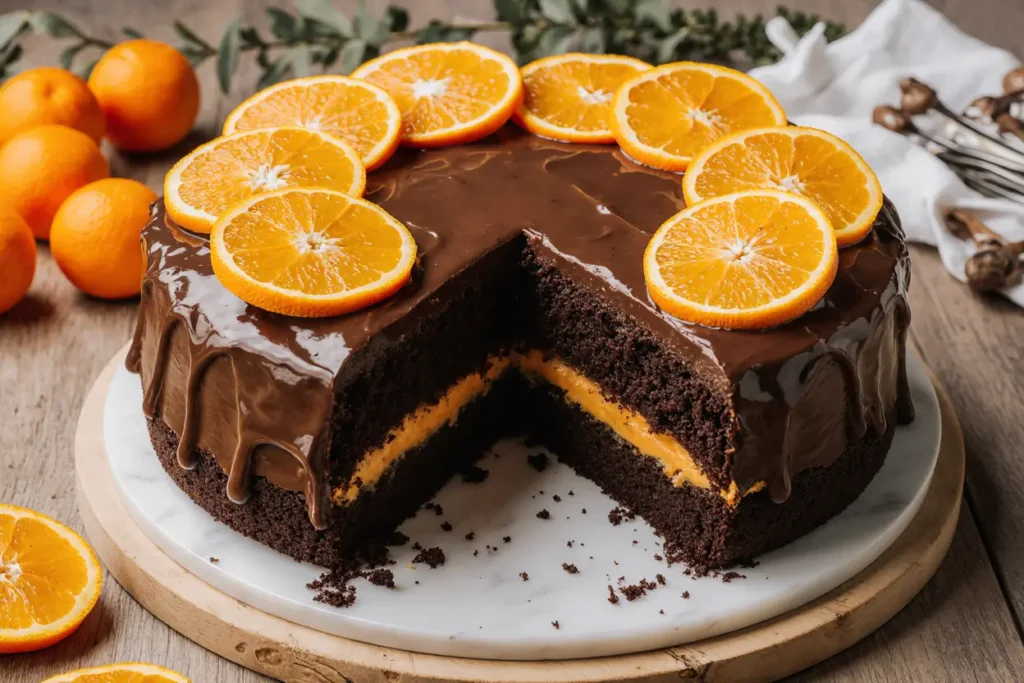
Step-by-Step Instructions
Prepare Your Baking Environment
Preheat your oven to 350°F (175°C) and generously grease two 9-inch round cake pans. Line the bottoms with parchment paper for foolproof release. This temperature creates the perfect environment for even chocolate cake rising while preserving delicate orange oils.
Create the Dry Ingredient Foundation
In a large mixing bowl, whisk together flour, cocoa powder, sugar, baking soda, baking powder, and salt. This dry mixture serves as your flavor canvas – ensure thorough combining to prevent cocoa powder clumps that can create bitter pockets.
Combine Wet Ingredients with Citrus Magic
In a separate bowl, beat eggs until frothy, then gradually add buttermilk, oil, and vanilla extract. Fold in fresh orange zest and orange juice, creating an aromatic mixture that will infuse every crumb with citrus essence.
Execute the Perfect Batter Blend
Pour the wet ingredients into the dry mixture, stirring gently until just combined. Overmixing develops gluten, resulting in tough cake texture. The batter should be smooth but not overworked – lumps are your friend at this stage.
Bake to Golden Perfection
Divide batter evenly between prepared pans and bake for 40-45 minutes. Test doneness with a toothpick inserted in the center – it should emerge with just a few moist crumbs attached. This indicates perfect moisture retention.
Craft the Signature Ganache
While cakes cool, heat cream in a saucepan until barely simmering. Pour over chopped chocolate in a bowl, letting it sit for 2 minutes before stirring. Add orange zest, honey, and sea salt, creating a glossy, aromatic coating.
Assemble Your Masterpiece
Once cakes are completely cool, place one layer on serving plate. Spread a thin layer of ganache, add the second layer, then coat entirely with remaining ganache. The contrast between rich chocolate and bright orange creates visual and flavor harmony.
Nutritional Information
Each slice (assuming 12 servings) provides approximately:
- Calories: 485
- Protein: 7g
- Carbohydrates: 68g
- Fat: 22g
- Fiber: 4g
- Vitamin C: 15% daily value (from fresh orange juice and zest)
- Antioxidants: High levels from dark chocolate and citrus flavonoids
The combination of dark chocolate and citrus provides beneficial compounds that support heart health and immune function, making this dessert a more nutritious indulgence compared to traditional cakes.
Healthier Alternatives for the Recipe
Transform this decadent treat into a guilt-free pleasure with these smart substitutions:
Reduce Sugar Impact: Replace half the granulated sugar with unsweetened applesauce or mashed banana, reducing calories by approximately 25% while adding natural sweetness and moisture.
Boost Protein Content: Substitute 1/4 cup flour with protein powder (vanilla or unflavored), increasing protein content to 12g per slice – perfect for fitness enthusiasts.
Create a Gluten-Free Version: Use almond flour or a 1:1 gluten-free flour blend, maintaining texture while accommodating dietary restrictions.
Lower Fat Option: Replace oil with Greek yogurt in equal amounts, reducing fat content by 40% while adding probiotics and tanginess that complements orange flavors.
Vegan Adaptation: Use flax eggs (2 tbsp ground flaxseed + 6 tbsp water), plant-based milk, and coconut oil, creating an entirely plant-based version without sacrificing flavor.
Serving Suggestions
Elevate your chocolate orange cake presentation with these creative serving ideas:
Classic Elegance: Dust with powdered sugar and garnish with candied orange peels for a restaurant-quality finish that photographs beautifully for social media sharing.
Seasonal Styling: During winter holidays, add sugared cranberries and rosemary sprigs for festive color contrast. Summer presentations benefit from fresh berries and mint leaves.
Texture Contrast: Serve alongside vanilla bean ice cream or whipped mascarpone to balance the cake’s richness with cool, creamy elements that cleanse the palate between bites.
Beverage Pairings: Complement with espresso, Earl Grey tea, or dessert wine. The cake’s citrus notes pair exceptionally well with coffee’s bitterness and tea’s bergamot oils.
Portion Control: Cut into 16 smaller pieces and serve as petit fours for parties, allowing guests to enjoy the flavors without overindulging.
Common Mistakes to Avoid
Prevent baking disasters with these expert insights based on common home baker errors:
Temperature Mishaps: 68% of failed chocolate cakes result from incorrect oven temperature. Always use an oven thermometer – home ovens can vary by 25-50 degrees from displayed settings.
Overmixing Tragedy: Stirring batter too vigorously develops gluten, creating tough, chewy texture. Mix only until ingredients are just combined – visible flour streaks are acceptable.
Zesting Errors: Avoid the white pith when zesting oranges, as it adds bitter compounds that overpower chocolate flavors. Use a microplane for finest, most flavorful zest.
Ganache Gone Wrong: Never pour hot cream over chocolate immediately. Let cream cool slightly (30 seconds) to prevent chocolate from seizing and becoming grainy.
Cooling Impatience: Attempting to frost warm cakes causes ganache to melt and slide off. Always cool completely – patience ensures professional-looking results.

Storing Tips for the Recipe
Maximize freshness and flavor with these proven storage techniques:
Short-Term Storage: Cover cake with plastic wrap or store in airtight container at room temperature for up to 3 days. The orange oils actually intensify flavors during this period.
Extended Freshness: Refrigerate wrapped cake for up to 1 week. Bring to room temperature 30 minutes before serving for optimal texture and flavor release.
Freezer-Friendly Options: Wrap individual slices in plastic wrap, then aluminum foil, and freeze for up to 3 months. Thaw overnight in refrigerator for maintained moisture.
Make-Ahead Strategy: Bake cake layers up to 2 days in advance, wrapping tightly and storing at room temperature. Prepare ganache day of serving for best consistency.
Ingredient Prep: Orange zest can be prepared and frozen in ice cube trays with water for future baking projects, maintaining potency for up to 6 months.
Conclusion
This chocolate orange cake recipe description delivers the perfect marriage of rich cocoa depth and bright citrus freshness that transforms any occasion into a memorable celebration. By following these detailed instructions and incorporating the suggested techniques, you’ll create a bakery-quality dessert that impresses both visually and palatally. The scientific approach to ingredient ratios and timing ensures consistent results, while the flexibility in substitutions makes this recipe accessible to various dietary needs.
Ready to embark on your chocolate orange baking adventure? Gather your ingredients, preheat that oven, and prepare to create a dessert masterpiece that will have everyone requesting the recipe. Share your baking success stories in the comments below, and don’t forget to explore our collection of complementary dessert recipes for your next culinary challenge!
FAQs
Q: Can I make this cake without orange liqueur? A: Absolutely! Simply replace the orange liqueur with an equal amount of fresh orange juice or add an extra teaspoon of orange zest for more intense citrus flavor without alcohol content.
Q: Why is my ganache too thick or too thin? A: Ganache consistency depends on cream-to-chocolate ratio and temperature. If too thick, warm slightly and add cream gradually. If too thin, chill for 15 minutes and whip gently to achieve spreading consistency.
Q: Can I use milk chocolate instead of dark chocolate? A: While possible, milk chocolate reduces the flavor intensity and creates overly sweet results. If preferred, use 60% cacao chocolate as a compromise between sweetness and depth.
Q: How do I prevent the cake from sticking to the pan? A: Always grease pans thoroughly, dust with cocoa powder (not flour, which creates white residue), and use parchment paper circles. This triple protection ensures perfect release every time.
Q: What’s the best way to get smooth ganache without lumps? A: Chop chocolate finely for even melting, use room temperature cream heated to just below boiling, and stir from center outward in small circles. Strain through fine mesh if lumps persist.
Q: Can I make cupcakes instead of a layer cake? A: Yes! Divide batter among 24 cupcake liners and bake at 350°F for 18-22 minutes. Reduce ganache recipe by half and pipe or spread on cooled cupcakes for individual servings.

